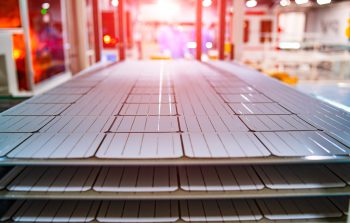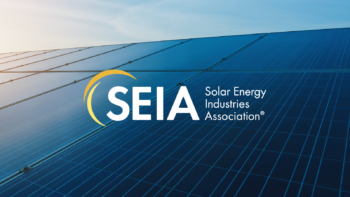Made in America: The Solar Manufacturing Renaissance is Here
By: SEIA's Comms Team
These new factories and facilities are creating well-paying jobs throughout the country and enhancing American competitiveness around the globe.
The American-made manufacturing boom is in full swing.
Clean energy incentives are driving American companies to increase production and invest billions of dollars to expand domestic solar manufacturing capacity. These new factories and facilities are creating well-paying jobs throughout the country and enhancing American competitiveness around the globe.
Solar manufacturing jobs are expected to more than triple over the next ten years, growing from about 35,000 jobs today to 120,000 by 2033. These investments are making solar more accessible and affordable for communities across the country while transforming America into a clean energy manufacturing powerhouse.
Investing in the solar supply chain is also an investment in American energy independence. Solar power helps us diversify our energy mix and reduce reliance on foreign energy sources, bolstering energy security and insulating American families from the volatile price shifts of global oil markets. No one can limit our access to the sun, and as the domestic solar supply chain strengthens, America positions itself to dominate the clean energy economy.
From the Great Plains to the Sunbelt, America’s manufacturing renaissance is uplifting communities and transforming lives. The announcements highlighted below are just a few examples of the massive investments and job creation happening across the nation.
Solar Manufacturing Soars in the Midwest
In May, OMCO Solar opened its fifth U.S. manufacturing facility in Warsaw, Indiana.
Warsaw and its neighbors in Indiana have long been dependent on fossil fuels as their main source of energy. However, low grid-connection costs and the influx of manufacturing jobs are helping Warsaw and other communities across the Midwest benefit from solar growth.
The new OMCO facility will support the production of solar trackers, which are used to optimize the amount of sunlight hitting the panels and maximize the energy they produce. As Midwestern states build up their manufacturing capabilities, state and local economies will thrive, and the entire U.S. solar supply chain will benefit.
Fueling the Solar Surge in the Peach State
Dalton, Georgia is welcoming $2.5 billion in solar manufacturing investments that will support the entire supply chain and create more than 2,500 jobs. In Dalton, Qcells will add 2 GW of solar module assembly capacity, bringing the company’s total solar panel production capacity in Georgia to 8.4 gigawatts by 2024.
The Qcells facility is already having a ripple effect on nearby counties in Georgia.
In Cartersville, Georgia, Hanwha Advanced Materials Georgia (HAGA) is building a new manufacturing facility that will supply encapsulant films for Qcells, a critical material that helps to make solar cells more durable. The new facility in Cartersville is a prime example of the cascading positive effects of solar investments in the United States and is expected to add $147 million in private investments and 160 jobs.
“The new plant will bring more than 160 new jobs to the Bartow area and will produce materials used to encapsulate solar cells and ensure long-term panel durability,” said Cartersville Mayor Matt Santini in a statement released by Governor Kemp’s office. “Georgia is quickly becoming a leader of the American solar supply chain, delivering good, family sustaining jobs to Georgians of all backgrounds.
“Georgia is leading the nation in attracting next generation jobs,””¯said Georgia Governor Brian Kemp. “Since we first welcomed Qcells to our state in 2018, we’ve announced more than 4,000 related jobs for hardworking Georgians. We’re proud that Hanwha Advanced Materials is adding to that growing number as it becomes a valued member of the Bartow County community.”
Arizona Charges Up Battery Cell Production
U.S. battery developer Kore Power is partnering with Siemens to build a new battery cell factory in Buckeye, Arizona. The plant will be one of the first gigafactories for battery cells in the United States that’s not affiliated with an automaker, enabling it to serve a wider range of customers.
Now that standalone energy storage systems qualify for federal tax credits, increasing battery manufacturing capacity will be critical to meet the growing demand for home battery systems. By 2027, solar and storage attachment rates for residential solar are expected to reach 33%. These numbers will only grow as battery prices drop and communities prioritize resilience.
Tennessee Solar Workers Anchor Manufacturing Growth
Nextracker is working with MSS Steel Tubes USA on a new factory to manufacture low-carbon steel components for solar tracking systems in Memphis, Tennessee. The facility will create 129 jobs, generate millions of dollars in local economic investment and support projects in Kentucky, South Carolina, Virginia, Mississippi, and Georgia. This facility showcases just how connected the solar supply chain already is in the southern United States. Nextracker has already signed an agreement with Silicon Ranch, a Tennessee-based developer, to supply their projects throughout the region.
As the solar supply chain grows, so does the solar workforce and the surrounding communities.
“I want to honor the workers here,” said SEIA President and CEO Abigail Ross Hopper at the dedication of the new Memphis factory. “You’re the ones getting this done. Helping to contribute to resilient power, energy security and American manufacturing for the clean economy.”
The American manufacturing renaissance is here thanks to bipartisan policies and investments. For the first time in decades, domestic manufacturing and the U.S. solar supply chain are growing from coast to coast.
American energy security, reliability, and independence has never been stronger.



